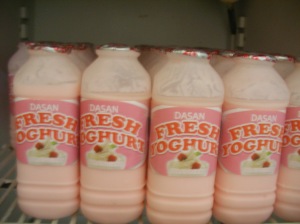As I take a journey down memory lane, I reminisce the good times I
had during my undergraduate years at the Kwame Nkrumah University of
Science and Technology (KNUST). There, I made new and wonderful friends
and got introduced to a lot of campus life activities. Of all the things
I got introduced to, there is one I very much appreciate; The Drink
(please don’t jump to conclusion, am no glutton. I just enjoy good
food).
It was consumed by almost everyone on campus, lecturers and students
alike. Every market in the halls of residence had it on sale. And at the
KNUST Commercial area, one was bound to find many people queued to buy
it as if it was the launch of the iPhone N. The sellers here, made sure
there was hot pancake to accompany it. Drink-ups were not void of it and
most often, it featured on the ‘Item 13’ of students’ gatherings. The
reading rooms and students’ learning desks were all decorated with this
drink. And O! One could not meet a couple taking a lovers’ stroll on
Friday nights without this third party – the drink. Of all the places
that sold this drink, the best place I loved to make purchase was at the
Department of Biochemistry and Biotechnology mini shop stationed behind
the Chemistry block. This was because, I was sure that the drink
contained the live cultures (probiotics) I needed for my digestive
system.
Interestingly, this was the same drink; a food company in Ghana
introduced onto the Ghanaian market some years back and was rejected by
the sweet toothed Ghanaian claiming it was sour. But here it was on
KNUST campus, doing so well with its demand sky rocketing. The demand
for this drink is not only high in KNUST but in most western countries.
To tell you the truth, the reason I took delight in taking this drink
for the first two years on campus had nothing to do with the drink’s
usefulness to my body. I took it for its sweet sour taste and also
because it was very filling (considering my limited budget for food) and
sustained me for longer lecture hours. Additionally, I thought the
drink to be healthy (less sugar and little or no food additive). Perhaps
the noise about it on campus, made me join others in consuming this
drink (this is no peer pressure). These reasons I believe would be what
many students would give for consuming this drink. It was not until my
third year in Biochemistry almost the same time I began having problems
with milk intake (details in my previous blog, IT’S MILK….)
that I came to appreciate its importance. Had the preparation of this
drink being taught in the first year of Biochemistry, I am certain, many
of my course mates including myself would have gladly abandoned the
frustrating fascinating Biochemistry programme and started a business
producing this drink. How wise of our lecturers to have saved the best
for the last and now we can boast of being Biochemists, who are fully
prepared to contribute our quota to society.
The benefits of the drink are numerous and research into its
importance is still underway. Below, are some importance of it to the
body:
- It contains beneficial bacteria called probiotics, which are able to repopulate and sustain healthy bacteria in the intestines, which fight infections consequently boosting one’s immune system.
- It is rich in calcium, phosphorus, riboflavin, iodine and contains good amounts of vitamins B12 and B5, potassium, zinc, protein and molybdenum.
- According to a research carried out by the International Journal of Obesity, the drink’s consumption showed significant weight loss among obesed adults.
- For the lactose intolerant, the drink serves as a best substitute for lactose-containing products as the lactose in the drink has fermented into lactic acid thereby eliminating the possibility of any stomach troubles (details in my previous blog, IT’S MILK….).
- And for the female suffering from vaginal infections, the drink can help maintain a healthy balance of natural bacteria in the vagina.
- Select brands containing rich amounts of live probiotics culture. These means traditionally fermented yoghurt is the best choice.
- Go for the freshest yoghurt on the market by checking the production dates and expiration dates. The closer the date of your purchase is to the production date, the fresher the yoghurt.
- Avoid yoghurt containing high amounts of sugar, and additives.
- As it is a fresh dairy product, it must always be stored in refrigerators and not on the heads of street hawkers. Heat is likely to destroy the live probiotics culture.
Friend, make yoghurt a part of your diet. It is not only good for the lactose intolerant but for you as well.




 Posted in:
Posted in: 





0 comments:
Post a Comment